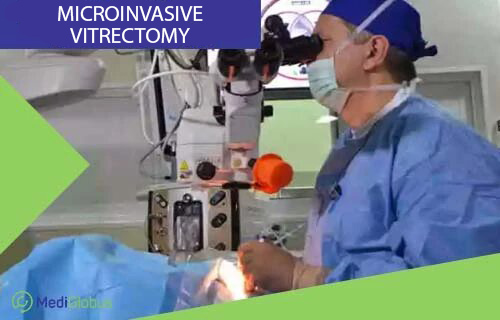According to The Eyes of the World website, around 1,1 billion people in the world have a visual impairment. In 90% of cases, vision loss is treatable. Sometimes this requires a surgical procedure. Vitrectomy is one such surgery that treats various ocular diseases. It includes removing the vitreous body from the eye, and sometimes other tissues as well, to restore or preserve the patient’s vision. Currently, several modern vitrectomy techniques are used in clinics around the world. This article will explain how vitrectomy is performed abroad and how much it costs.
Listen to the article:
What is a vitrectomy and when is it necessary?

A vitrectomy is a surgical procedure in which the vitreous body – the gel-like substance that fills the eye cavity – is completely or partially removed from the eye.
The procedure can be performed either alone or in combination with other eye surgeries, depending on the specific diagnosis and needs of the patient.
Vitrectomy is performed for a variety of ocular conditions related to the ocular fundus and vitreous body. Some of the most common conditions for which surgery may be required are:
Retinal detachment | In this pathology, the retina detaches from the back of the eye, resulting in loss of vision. Vitrectomy is used to remove the fluid, restore the retina and remove the cause of the detachment. |
Macular dystrophy | This is a disease that affects the macula, the area of the retina responsible for central vision. Surgery is performed to remove haemorrhages, regulate the retina, and improve the function of the macula. |
Diabetic retinopathy | This disorder is caused by diabetes mellitus and leads to damage to the retina. In such cases, surgical interventions are performed to remove vascular lesions, haemorrhages and scars. |
Macular hole | This is a hole or defect in the macula. In this case, a vitrectomy is performed to close the hole and restore central vision. |
Haemophthalmos | Intraocular haemorrhage can cause visual impairment. During surgery, the surgeon removes the blood and restores visual function. |
Vitrectomy techniques
Depending on which area of the eye the pathological changes occur, vitrectomy is divided into 3 types:
Anterior vitrectomy – removal of part of the vitreous body from the anterior structures of the eye;
Posterior vitrectomy – removal of part of the vitreous body from the back of the eye;
Total vitrectomy – the vitreous body is completely removed from the eye. Then, after the necessary manipulations, the cavity is filled with gas, silicone oil or gel.
Different methods of surgery are used depending on the specific situation and purpose.
A microinvasive vitrectomy is a modern approach to surgery. It is performed through tiny openings. Special instruments and equipment are used in the process: vitreotome, fibre optic light, ophthalmoscope, optical tomograph and lenses to visualise the process. This improves the accuracy of the surgical procedure and reduces the trauma to the surrounding tissue. The advantages of micro-invasive surgery are quicker recovery and less risk of complications.

Vitrectomy with gas tamponade is performed after the removal of the vitreous body. The eye is filled with a special gas or air that keeps the retina in the correct position until it has fully recovered. Later on, the gas will dissolve on its own within a few weeks or months. In some cases, a vitrectomy using a liquid tamponade may be performed instead of a gas tamponade. After the vitreous body is removed, the resulting cavity is filled with a liquid, either silicone oil or perfluorooctane. The advantage of the operation is a longer-lasting support of the structures of the eye. However, after some time the fluid has to be drained, which requires a second intervention.
During surgery, it is sometimes necessary to remove the lens of the eye to have better access to the back of the eye. After all necessary procedures are completed, the lens is replaced after a vitrectomy to restore full vision.
Vitrectomy for retinal detachment removes fluid that has accumulated between the retina and the choroidal membrane and secures the retina in the correct position.
A repeated vitrectomy is required when the initial operation has not achieved the desired results or some complications require a second intervention. A repeat vitrectomy may be more complicated and require more careful planning and approach to achieve the best results.
How is a vitrectomy performed?
The course of surgery usually begins with local anaesthesia of the eye. First, the surgeon makes small incisions in the sclera of the eye, through which the vitreotome and other necessary instruments are inserted. The vitreous body and/or other tissues are then removed. If necessary, additional procedures such as laser photocoagulation or implantation of an artificial lens are performed. At the end of the operation, the incisions are treated and covered with a dressing.
Recovery from vitrectomy is an important step in the treatment process. Patients are prescribed certain medications to prevent inflammation and infection and to help the eye heal. Restriction of activity may be recommended in the first days or weeks after surgery to prevent damage to the eye and ensure successful healing.
Advantages of vitrectomy in different countries
Treatment for eye diseases abroad is provided in general hospitals or specialised clinics. Patients choose Turkey, Israel, South Korea or Germany for eye treatment. Foreign clinics use state-of-the-art equipment and instrumentation and employ world-class ophthalmologists. Specialists are proficient in modern surgical techniques and adhere to international quality and safety standards.
Turkey
Turkey offers high-quality eye care at affordable prices, including vitrectomies. Approximately 16 million people come to this country every year for eye treatment. Medical centres are equipped with state-of-the-art technology. In treating eye pathologies, they use cutting-edge laser equipment, 3D visualisation devices, and optical equipment from the world’s leading manufacturers. Turkish ophthalmologists receive training in the best schools in Europe and the USA. Doctors and personnel speak English and other languages, which facilitates communication and the provision of quality medical care to all patients.
For eye disease treatment in Turkey, patients choose:
The approximate cost of a vitrectomy in Turkey in 2023 starts from $1,200.
Contact MediGlobus Medical Platform Coordinator for an appointment for a vitrectomy in Turkey.
Israel
Israel is one of the leading countries in the field of ophthalmology. It uses cutting-edge technology, employs qualified medical professionals, and ensures high standards of treatment. The tools and supplies used for eye surgery are of the highest quality. For example, high-grade silicone oils are used in vitrectomy procedures. This reduces the recovery period to 2 weeks. Online consultations with leading Israeli ophthalmologists are available for overseas patients. Prices for treatment in this country are 40% lower than in the USA. Besides, Israeli medical establishments are renowned for their scientific research facilities making innovations in the field of ophthalmology.
Vitrectomy with modern and safe methods is performed in Israeli clinics:
The average cost of a vitrectomy in Israel starts at $4,900.
If you need a vitrectomy, please contact the MediGlobus team. We will book an appointment with your doctor, find a clinic in Israel and assist you with relocation.
South Korea
South Korea is one of the leaders in the field of medical tourism. Many clinics and hospitals are equipped with the latest models of medical equipment. For example, new models of Samsung medical equipment appear in Korean clinics earlier than in other countries. Korean professionals in the field of ophthalmology undertake practical training in the leading medical centres of the USA, Canada, and Europe. Patients choose Korea for treatment as the maximum comfort conditions are provided here, including translation services, personal coordinator service, transfer and comfortable accommodation for the period of examination or therapy. It is also noteworthy that the prices for medical services in South Korea are 20% lower than in Europe.
For vitrectomy in South Korea patients go to:
The approximate cost of a vitrectomy in Korea starts from $2,500.
If you are interested in treatment in South Korea, please contact the MediGlobus Medical Platform. We will book an appointment with an ophthalmologist without waiting in line and help to arrange a trip to South Korea.
Germany
Germany is an attractive country for medical tourism due to its high reputation in the field of healthcare, modern clinics and comfortable living conditions for foreign patients. The doctors and staff have a high level of professionalism and experience in the field of ophthalmology. This is why the rate of medical errors in Germany is among the lowest in Europe. One of the most important aspects taken into account by German ophthalmologists is pre-operative diagnostics. The clinics perform thorough examinations and consultations to determine an effective treatment plan and approach for each patient. The doctors take into account the individual characteristics of the patient, the severity of the disease and other factors to achieve the best possible results. After a vitrectomy in Germany, patients are offered high-quality medical care and follow-up during the whole treatment period.
For treatment of eye pathologies in Germany, patients go to:
The cost of a vitrectomy in Germany starts at €2,000.
To take advantage of medical options in Germany, please contact the MediGlobus coordinator. We will help you find the best clinic, make an appointment and organise your trip.
Summary
Vitrectomy is performed for retinal pathologies, diabetic retinopathy, macular lesions and defects, and other eye diseases.
Minimally invasive vitrectomy is a modern and safe method of eye recovery.
Patients prefer vitrectomy in Turkey, Israel, South Korea, and Germany.
The cost of a vitrectomy depends on the type and complexity of the surgical intervention, the severity of the pathology, as well as the pricing policy of the clinic and the qualifications of the ophthalmologist.













